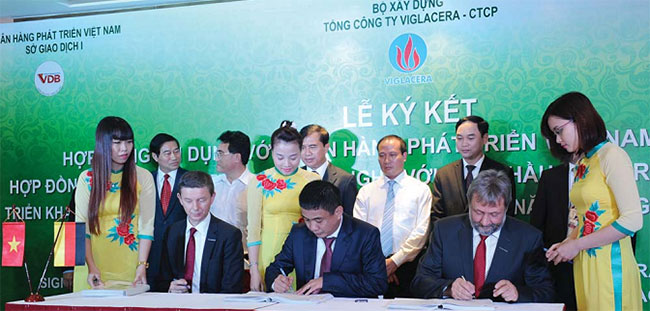Viglacera introduces innovative low-e glass to Vietnam

Viglacera’s new project will produce 2.3 to 3.3 million square metres of its innovative low-e glass
The total investment cost of Viglacera’s low-e glass assembly facility is $22.3 million, with its core components using innovative technology from Von Ardenne GmbH, a erman corporation with expertise on energy-saving glass solutions.
The assembly is scheduled to finish in October 2016, with the estimated capacity of 2.3 to 3.3 million square metres per year. Moreover, to accommodate different decorative needs, the new low-e glass will have multiple colour options.
As the project partner, Von Ardenne GmbH will also transfer its equipment and skills on energy-saving glass production to Viglacera’s Binh Duong factory, operated by a subsidiary named Viglacera Floating
Glass Company (VIFG).
According to VIFG managing director Nguyen Minh Khoa, Von Ardenne GmbH is among the few global corporations with profound knowledge on low-e glass production, making the German firm the obvious choice as Viglacera’s partner after a long selection process. Apart from Von Ardenne GmbH, Viglacera has signed a $15-million credit contract with the Vietnam Development Bank to finance the project.
Furthermore, the firm partnered up with Sado Group and Eurowindow, the two leading after-glass companies in Vietnam, to ensure its low-e glass products have a large customer base right after the 2016 launch. Also on this occasion,
VIFG has been awarded the High-Technology Project Certificate by the Ministry of Science and Technology. Nguyen Quang Cung, deputy head of the Vietnamese Association of Construction
Materials, noted that Vietnam was in great need of energysaving materials like Viglacera’s upcoming low-e glass, especially after the real estate industry starts showing signs of recovery. This energy-saving glass segment is still dependent on imported materials, thus Viglacera’s initiative will fill in
a large gap.
“Low-e glass is the key to cutting electricity costs for building projects, preserving the health of tenants and increasing investment returns. Thanks to its versatility, high efficiency, and solar control coating, low-e glass can minimise heat loss through its body, thus saving electricity while keeping the inside of the building cool. This is in line with global construction trends and suitable for the humid Vietnamese conditions,” said Cung.
Meanwhile, Khoa noted that the market for Vietnamese energy-saving glass held high potential which would be aided by the booming real estate industry. With the new low-e glass assembly, VIFG expects
to capitalise on this opportunity and expand its market size in Vietnam.
“First, the new low-e assembly will not raise the capacity of our floating glass factory, but instead improve the quality of our products and provide customers with a wider range of choices for their energy-saving needs. Second, our affordable low-e glass will also help reduce the amount of imported
glass, which tends to be extremely expensive. Third, the improved solar-coating technology will reduce one layer of glass, thus allowing our customers to cut more material costs. Overall, we believe that the new low-e glass project will showcase our responsibility towards Vietnamese customers and the domestic glass industry,” said Khoa.
Within the past three years, VIFG’s floating glass factory has operated at maximum capacity to meet the growing demand from both Vietnam and overseas. With the upcoming low-e glass production slated
for 2016, Khoa hoped that the firm would increase its profitability by 70 per cent and manufacturing value by 5 per cent in the next few years. In 2014, the export quota of VIFG increased by 32 percent while the firm accounted for 23 per cent of the domestic floating glass market. The company’s annual revenue reached $44.6 million, and VIFG also received the World Quality Commitment Award by Business Initiative Directions for the second time, showing the firm’s ongoing commitment to product quality and innovation.
What the stars mean:
★ Poor ★ ★ Promising ★★★ Good ★★★★ Very good ★★★★★ Exceptional
Latest News
More News
- Mitsubishi Estate launches Logicross Hai Phong - a milestone in logistics evolution (November 20, 2024 | 14:32)
- Semiconductor workforce partnerships deliver industry-relevant training (November 20, 2024 | 10:58)
- German Quickpack to invest $31.7 million in Long An province (November 20, 2024 | 09:31)
- Foreign-invested enterprises drive logistics investment in the southeast region (November 20, 2024 | 09:27)
- Chile visit underscores trade benefits (November 19, 2024 | 10:00)
- Trump’s second term impacts sci-tech activities and industry 4.0 technologies (November 18, 2024 | 10:00)
- Vietnam eyes nuclear revival to bolster energy security (November 14, 2024 | 16:46)
- Kyokuyo completes $13.5 million seafood factory in Vietnam (November 14, 2024 | 12:19)
- VinFast receives $3.5 billion funding from Vingroup and Pham Nhat Vuong (November 14, 2024 | 06:38)
- Localities sprint to reach FDI targets (November 13, 2024 | 10:00)


















 Mobile Version
Mobile Version